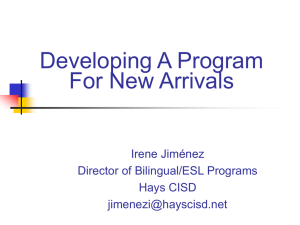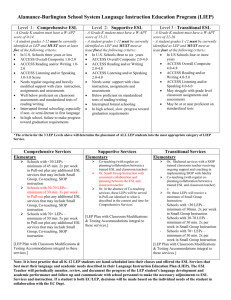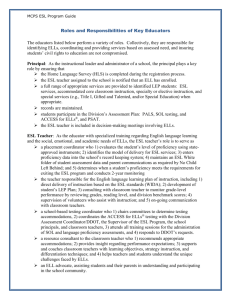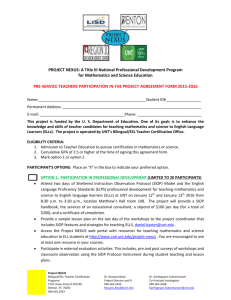SIOP Your Co
advertisement
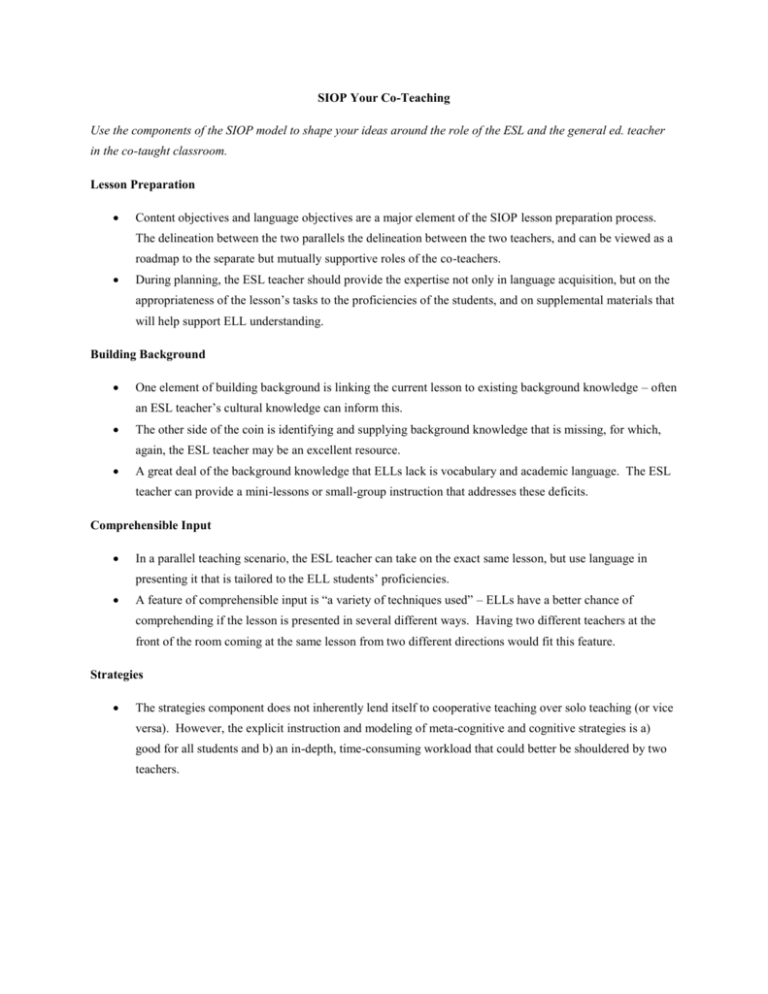
SIOP Your Co-Teaching Use the components of the SIOP model to shape your ideas around the role of the ESL and the general ed. teacher in the co-taught classroom. Lesson Preparation Content objectives and language objectives are a major element of the SIOP lesson preparation process. The delineation between the two parallels the delineation between the two teachers, and can be viewed as a roadmap to the separate but mutually supportive roles of the co-teachers. During planning, the ESL teacher should provide the expertise not only in language acquisition, but on the appropriateness of the lesson’s tasks to the proficiencies of the students, and on supplemental materials that will help support ELL understanding. Building Background One element of building background is linking the current lesson to existing background knowledge – often an ESL teacher’s cultural knowledge can inform this. The other side of the coin is identifying and supplying background knowledge that is missing, for which, again, the ESL teacher may be an excellent resource. A great deal of the background knowledge that ELLs lack is vocabulary and academic language. The ESL teacher can provide a mini-lessons or small-group instruction that addresses these deficits. Comprehensible Input In a parallel teaching scenario, the ESL teacher can take on the exact same lesson, but use language in presenting it that is tailored to the ELL students’ proficiencies. A feature of comprehensible input is “a variety of techniques used” – ELLs have a better chance of comprehending if the lesson is presented in several different ways. Having two different teachers at the front of the room coming at the same lesson from two different directions would fit this feature. Strategies The strategies component does not inherently lend itself to cooperative teaching over solo teaching (or vice versa). However, the explicit instruction and modeling of meta-cognitive and cognitive strategies is a) good for all students and b) an in-depth, time-consuming workload that could better be shouldered by two teachers. SIOP Your Co-Teaching (cont’d.) Interaction The focus of the interaction component is to steer teachers away from the “stand and deliver” lecture model that is proven to be ineffective with ELLs. The presence of two teachers in and of itself opens up the possibilities for varying student interactions. Small groups, partners, and one-on-one teacher-student interactions are all better facilitated with two adults in the room. “Clarify concepts in L1” is a feature of the interaction component. If the ESL teacher is bilingual, this is now a thing that can happen – keeping in mind that this is never the sole function of an ESL teacher. Practice/Application This is the component that addresses providing ample time and opportunity for students to practice their new skills and concepts and the academic language that goes along with them in a low-risk, high-support environment. Like the Strategies component, co-teaching offers no inherent advantages or disadvantages beyond the presence of more teachers in the room to guide that practice and application. Lesson Delivery The first feature of lesson delivery is “Support content and language objectives during lessons.” Clearly, supporting language objectives is the time for the ESL teacher to strut his or her language-developmentexpert stuff, whether through mini-lessons, small-group work or teaching the content to the whole group through a lesson or activity centered on the language. Review and Assessment The SIOP model regards assessment as an ongoing process that happens pretty much non-stop throughout the class time. In this light, many different interactions between student and teacher can serve as a form of assessment. Two teachers, one with a content focus and one with a language focus, can employ assessment strategies as the lesson unfolds and re-pace it accordingly.






